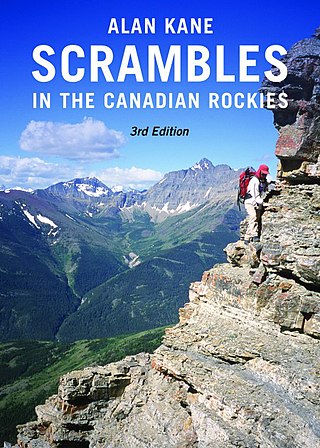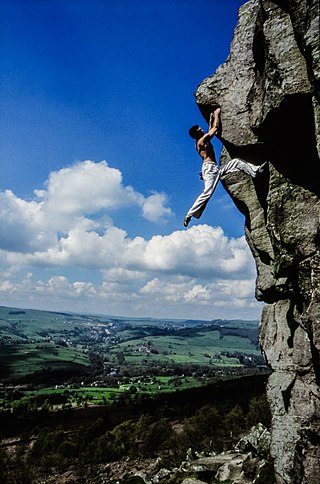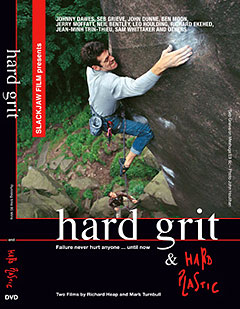
Bouldering is a form of free climbing that is performed on small rock formations or artificial rock walls without the use of ropes or harnesses. While bouldering can be done without any equipment, most climbers use climbing shoes to help secure footholds, chalk to keep their hands dry and to provide a firmer grip, and bouldering mats to prevent injuries from falls. Unlike free solo climbing, which is also performed without ropes, bouldering problems are usually less than six metres (20 ft) tall. Traverses, which are a form of boulder problem, require the climber to climb horizontally from one end to another. Artificial climbing walls allow boulderers to climb indoors in areas without natural boulders. In addition, bouldering competitions take place in both indoor and outdoor settings.

Glossary of climbing terms relates to rock climbing, mountaineering, and to ice climbing.

Solo climbing, or soloing, is a style of climbing in which the climber climbs a route alone, without the assistance of a belayer. By its very nature, it presents a higher degree of risk to the climber, and in some cases, is considered extremely high risk. Note that the use of the term "solo climbing" is generally separate from the action of bouldering, which is itself a form of solo climbing, but with less serious consequences in the case of a fall. The most dangerous form of solo climbing is free solo climbing, which means both climbing alone and without any form of climbing protection.

Climbing guidebooks are used by mountaineers, alpinists, ice climbers, and rock climbers to locate, grade, and navigate climbing routes on mountains, climbing crags, or bouldering areas. Modern route guidebooks include detailed information on each climbing route, including topo diagrams, route beta, protection requirements, and the ethics and style that are in place for a given climbing area.

Fair Head or Benmore is a 5-kilometre (3.1 mi) long, 200-metre (660 ft) high, mountain cliff, close to the sea, at the north-eastern corner of County Antrim, Northern Ireland. The cliff's sheer and vertical 100-metre (330 ft) high dolerite rock face is shaped into distinctive vertical columns like organ pipes, which formed 60 million years ago when a sill of igneous rock was injected between horizontal Carboniferous sediments.

Johnny Dawes is a British rock climber and author, known for his dynamic climbing style and bold traditional climbing routes. This included the first ascent of Indian Face, the first-ever route at the E9-grade. His influence on British climbing was at its peak in the mid to late-1980s.
John Sherman, nicknamed Verm is an American rock climber and a pioneer in the promotion and development of the climbing discipline of bouldering. He is also a climbing writer and outdoor photographer, and the originator of the V-grade system, for grading the technical difficulty of boulder problems, which has since become one of the dominant grading systems worldwide.

Jerry Moffatt, is a British rock climber and climbing author who is widely considered as being the best British rock climber from the early-1980s to the early-1990s, and was arguably the best rock climber in the world in the mid-1980s, and an important climber in the history of the sport.
Mats are used for safety in gymnastics, and in training new skills. They are usually a piece of foam ranging from 1.5 to 28 inches thick, covered in a vinyl or plastic lining. The foam ranges in density from relatively firm to very soft.
The Fly is a short 25-foot (7.6 m) schist sport climbing or highball bouldering route in the Rumney Rocks climbing area, New Hampshire, USA, at the Waimea Cliff. The Fly was bolted by Mark Sprague in 1995 as an open project but did not see a first free ascent until David Graham, an 18-year-old American climber from Maine, climbed it in April 2000, who graded it 5.14d (9a) or V14 (8B+). It was quickly repeated by his climbing partner, Luke Parady. At the time, these ascents were milestones for climbing in North America.
Lisa Rands is an American rock climber. She is known for her bouldering for which in 2002, she became the first American female to win IFSC World Cup bouldering competitions, and topped the IFSC world boulder rankings in 2002. Rands was the first American female to climb boulders of grade V11 (8A), and V12 (8A+), and was the second-ever female in history to climb a 7C+/8A boulder. As well as making first female ascents (FFAs) of boulders such as The Mandala V12 (8A+), Rands was the first female in history to do an E8-graded traditional climbing route, The End of the Affair.

Hard Grit is a 1998 British rock climbing film directed by Richard Heap and produced by Slackjaw Film, featuring traditional climbing, free soloing, and bouldering on gritstone routes in the Peak District in Northern England. It is considered an important film in the genre and regarded as a historic and iconic film. The film starts with a dramatic fall by French climber Jean–Minh Trinh-Thieu on Gaia at Black Rocks. Hard Grit won ten international film festival awards.

Prinzip Hoffnung, is a 40-metre (130 ft) long traditional climbing route on a thin crack up a conglomerate rock slab on the "Bürs plate cliff" overlooking the village of Bürs in Vorarlberg, Austria. The route was greenpointied by Austrian climber Beat Kammerlander in 2009, and was one of the earliest traditional climbing routes to be graded at 5.14 R (American), 8b/+ (French), X/X+ (UIAA), or E9-E10 (British); it is still considered one of the hardest traditional climbing routes in the world.
Paul David Robinson is an American professional rock climber who specializes in bouldering. He has established and repeated several bouldering problems at the V15 difficulty rating, in such areas as Hueco Tanks, the Buttermilks, and Magic Wood. In 2007, Robinson became the second climber in history to successfully climb a V13 boulder problem in one attempt.
Ron Fawcett is a British rock climber and rock climbing author who is credited with pushing the technical standards of British rock climbing in traditional, sport, bouldering and free soloing disciplines, in the decade from the mid-1970s to the mid-1980s, and of pioneering the career of being a full-time professional rock climber. At the end of the 1970s to the early 1980s, Fawcett was widely considered the best and most notable rock climber in Britain.

In climbing and mountaineering, a traverse is a section of a climbing route where the climber moves laterally, as opposed to in an upward direction. The term has broad application, and its use can range from describing a brief section of lateral movement on a pitch of a climbing route, to large multi-pitch climbing routes that almost entirely consist of lateral movement such as girdle traverses that span the entire rock face of a crag, to mountain traverses that span entire ridges connecting chains of mountain peaks.
Angela Payne is an American rock climber specializing in bouldering, who won a clean sweep of the 2003-2004 US American Bouldering Series, and who in 2010, became the first-ever female in history to climb an 8B (V13) boulder.
The Hueco Rock Rodeo is a bouldering competition held annually in February at Hueco Tanks State Historic Site in the extremities of El Paso, Texas. It is highly competitive and attracts professional rock climbers from all over the world. The proceeds go toward conservation and access. The extreme competition was not the original intention of the event but with the growing popularity of bouldering, it has turned into one of the most difficult and coveted competitions to win. After 20+ years it is still a mainstay in the climbing community and is as much a festival as it is a serious competition.

Dreamtime is a 10-metre (33 ft) long gneiss bouldering route in a forest in Cresciano, Switzerland. When first solved in October 2000 by Swiss bouldering pioneer Fred Nicole, it was graded at 8C (V15), making it the world's first-ever boulder route at that grade. With subsequent repeat ascents, it was regraded to 8B+ (V14), but after the breaking of a key hold in 2009, its grade is now considered closer to 8C (V15). Dreamtime is the most notable bouldering route in climbing history along with Midnight Lightning, and is renowned for both its beauty and its challenge.

Barbara "Babsi" Zangerl is an Austrian rock climber who is widely considered as one of the best all-round female climbers in the world. At various stages in her career, she has climbed at, or just below, the highest climbing grades achieved by a female in every major rock climbing discipline, including bouldering, traditional climbing, sport climbing, multi-pitch climbing and big wall climbing.















